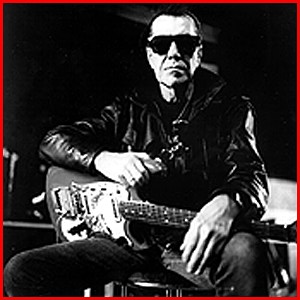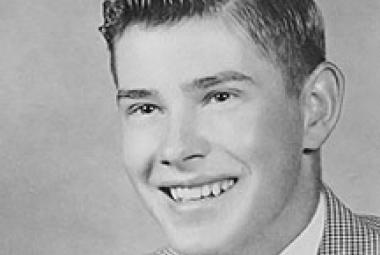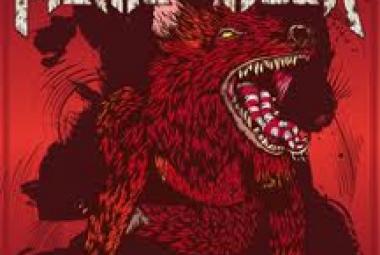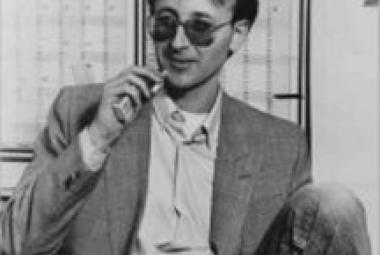UNDER-APPRECIATED ROCK BAND OF THE MONTH FOR FEBRUARY 2013: LINK PROTRUDI AND THE JAYMEN
Link Wray is one of the great heroes of rock and roll. He is a fellow North Carolinian – he was from Dunn – and his ancestry is half-Shawnee Indian. I have written about Wray before, and I will write about him again, believe you me. Link Wray is not exactly an unsung hero, but he is not nearly as well known as he should be. Early on, he played country and western music as Lucky Wray and the Palomino Ranch Hands.
Primarily though, he performed under the name Link Wray and His Ray Men (originally Link Wray and His Wray Men); there were a few other rock bands with the possessive – notably the legendary rock and roll pioneer Bill Haley and His Comets – but most bandleaders in the rock and roll era were content to just use “the” to identify the band.
While serving in the U. S. Army during the Korean War, Link Wray contracted tuberculosis; eventually, he lost one of his lungs. Doctors told him that he would never be able to sing, so he concentrated on perfecting his electric guitar technique. Some think he was strictly an instrumentalist, but he actually has a strong singing voice and briefly did a stint as a teen idol under the name Ray Vernon.
Link Wray and His Ray Men have a bonafide hit song to their name, “Rumble” which got as high as #16 (and that’s not bad at all for an instrumental); and they hit the singles charts twice more in the early part of his career. Not surprisingly, due to his Indian heritage, several of his recordings were named after Indian tribes: his own tribe, “Shawnee”, plus “Comanche” and “Apache”. The latter is by far the best known of these instrumental songs, though by other artists; Link Wray didn’t actually record it until 1990.
* * *
Amazingly, there seems to be a consensus that Link Wray will never make the Rock & Roll Hall of Fame, and I can’t think of anyone who deserves it more. To me, that is more of a commentary on the Hall of Fame than on Wray – that they are only making the obvious choices and not any that would ever raise any eyebrows. However, Link Wray has other accolades to his credit. He is a member of the Rockabilly Hall of Fame and the Native American Music Awards Hall of Fame. In 2009, the U. S. Library of Congress added “Rumble” to its National Recording Registry.
In the revised list that Rolling Stone magazine published in late 2012 of the “100 Greatest Guitarists” of all time, Link Wray made #45. Of this axe genius, RS notes: “By stabbing his amplifier’s speaker cone with a pencil, Wray created the distorted, overdriven sound that would reverberate through metal, punk and grunge.”
* * *
You can talk about your pioneers of rock and roll – Chuck Berry, Little Richard, Elvis Presley, James Brown, just to name a few – and you can even bring up your British Invasion greats – the Beatles, the Rolling Stones, the Animals, the Yardbirds, the Kinks, just to name another few. All of them are already in the Rock & Roll Hall of Fame, and deservedly so. However, you can play a lot of more modern rock records all day long and not really discern more than a hint of their direct influence; no question it’s in the DNA, but actual Elvis Presley-style vocals or Chuck Berry guitar licks or James Brown wails are elusive.
That is not so with Link Wray: His influence is front and center on a good 50% of the records that I play, because he is credited with introducing the “power chord” on electric guitar to rock and roll, a technique whose effect is often enhanced by distortion.
Writing for Allmusic, Cub Koda calls the power chord “the major modus operandi of modern rock guitarists”. I will spare you the technical details – not least because I don’t really understand them myself – but Ray Davies of the Kinks (in their classic “You Really Got Me”) and Pete Townshend of the Who (in “My Generation”) helped popularize the power chord in the early years of the British Invasion. When Townshend is performing his famous windmill guitar technique, he is typically playing power chords.
Pete Townshend has been quoted as saying: “He is the king. If it hadn’t been for Link Wray and ‘Rumble’, I would have never picked up a guitar.” More recently, concerning another Link Wray classic, Dan Auerbach of the Black Keys said: “I would listen to ‘Some Kinda Nut’, over and over. It sounded like he was strangling the guitar – like it was screaming for help.”
* * *
The very earliest power chords are credited to 1950’s bluesmen. Music historian Robert Palmer (not the same man as the 1980’s singer named Robert Palmer by the way) cites Willie Johnson (on Howlin’ Wolf’s “How Many More Years” that was recorded in 1951) and Pat Hare (on James Cotton’s “Cotton Crop Blues” that was recorded in 1954). If the name of the former song rings a bell, you are likely remembering “How Many More Times”, the last and longest track on Led Zeppelin’s 1969 debut album, Led Zeppelin. Under his real name, Chester Burnett, Howlin’ Wolf got a songwriting credit on later editions of the album. Anyway, the Brits liked what they heard and launched the British Invasion, and the rest is history.
Whether or not Link Wray heard these records and got the idea has not been established as far as I know. He refined his technique over a period of time during gigs. While working up an instrumental backing for their version of a really fine early rock and roll song “The Stroll” (originally by the Diamonds), Link Wray and His Ray Men hit upon a slow-paced but incredibly powerful instrumental that they first called “Oddball”. The first time they played it, it was a huge hit with the audience, who demanded four encores of the performance.
Phil Everly of the Everly Brothers reportedly heard the song and suggested the name “Rumble” since it sounded like a street fight to him. Archie Bleyer, a record producer for Cadence Records also heard about it but hated the song. However, Bleyer’s step-daughter Jackie Ertel and some of her friends loved the song. Some sources even say that Jackie Ertel, not Phil Everly came up with the name – the two later married.
* * *
Ultimately “Rumble” was released in 1958. Mostly the performance is simply Link Wray strumming his guitar in a menacing manner, backed up with a solid rock band; when you are doing something brand new, that is sometimes all it takes. Toward the end, Wray does some furious solos that any modern guitarist would be proud of and later begins to introduce distortion and feedback.
The song was banned in several major radio markets, including New York and Boston (perhaps self-censorship would be a better term, since it was mostly the DJ’s who took it upon themselves not to play the song) due to the fear that its rough sound glorified juvenile delinquency. Even Dick Clark sort of tip-toed around the controversy when the song was introduced on American Bandstand: He never actually mentioned the name of the song.
Yes, you read right: This instrumental song with no lyrics at all was banned in several cities across the country; no other American instrumental has ever suffered that indignity, though of course, there is no question that the controversy also helped record sales. Several of his other singles had similarly aggressive names: “Jack the Ripper”, “El Toro”, “Roughshod”, “The Stranger”, etc.
Not even Communist countries seemed to have problems with instrumental songs: I have two CD's of quite good rock instrumentals that were recorded and officially released in nations behind the Iron Curtain during the 1960’s; no doubt that there was plenty of censorship in Communist countries, but there was some rock and roll that was made available even there. When the British Invasion hit, even the Russkies had to let in some of the real stuff; this music was recorded before that.
* * *
To this day, the raw sound that Link Wray and His Ray Men generated in “Rumble” is somewhat startling; unlike much “ground-breaking” material that is left in the dust when other artists take the musical ideas and run with them, “Rumble” still casts something of a spell.
The 2008 documentary, It Might Get Loud shows rock guitarist legends from three generations discussing their music and their careers and their influences: Jimmy Page (the Yardbirds, Led Zeppelin), The Edge (U2), and Jack White (the White Stripes, the Raconteurs). Needless to say, they all three made the Rolling Stone list of 100 Greatest Guitarists also: #3, #38 and #70, respectively.
At one point, Jimmy Page starts flipping through a pile of 45’s and pulls out “Rumble”. To see a rock legend grooving along with that song, to see that big beaming smile on his face, to hear him discussing how the song developed, to see Page actually doing “air guitar” to “Rumble”: that really is something special. The clip from It Might Get Loud is well worth a viewing: www.youtube.com/watch?v=RLEUSn8y9TI .
* * *
Link Wray kept making records and went in and out of fashion. He didn’t last long with Cadence Records and continuously had fights with his record companies who wanted to tone down his sound, but he wasn’t having it. He always went his own way.
I purchased a reissue of what I believe is his first album from 1960, Link Wray & the Wraymen; that one hasn’t shown up among the albums that I have cleaned up from Katrina, but I keep hoping it will. More recently, I have picked up his 1979 release Bullshot, plus both albums that he recorded in 1977 and 1978 with the “bad boy of rockabilly”, Robert Gordon, When they quit playing together, Wray took most of the band with him, including drummer Anton Fig, and began touring on his own. Anton Fig would later join David Letterman’s band in 1986 that was led by Paul Shaffer called The World’s Most Dangerous Band; they later added a horn section, and he still plays with what is now known more tamely as the CBS Orchestra.
In 1994, Link Wray played on four songs with Alain Bashung; though unknown here, Bashung is one of the most celebrated singers and rock artists in France. Backed by Dutch musicians, Link Wray’s 1997 Shadowman album is considered to be a true comeback; and he continued recording and touring until four months before his death.
When Link Wray died in 2005, both Bob Dylan and Bruce Springsteen played “Rumble” live in tribute.
* * *
This month’s Under-Appreciated Rock Band of the Month, LINK PROTRUDI AND THE JAYMEN is obviously named in honor of Link Wray and His Ray Men. However, this is not a tribute band; while they have their versions of classics like “Night Train” and “The Stroll”, most of the songs that they play are originals.
The above album is a 1989 retrospective album, Missing Links of their original recordings and features one of the most over-the-top drawings of a rock band that I have ever seen. Besides a sample of their instrumental monsters, Side 2 includes a live performance of “Batman”, played against the backdrop of the original “Batman Theme” by Neal Hefti for the 1960’s Batman TV show. Midway through the performance, two of the bandmembers take a novel approach to the old rumor that Batman and Robin were the original Ambiguously Gay Duo by letting Robin admit to having a dalliance with Spider-Man.
Rudi Protrudi – who was born Glen Dalpis, but Rudi Action Protrudi is the name on his passport – is the frontman and lead singer of the one of the most popular and talented punk/psychedelic revival bands of the 1980’s, the Fuzztones. He formed Link Protrudi and the Jaymen in the spring of 1986 as an offshoot of the Fuzztones with their original bass guitar player Michael Jay and “Mad” Mike Czekaj, the man who would become the drummer when the Fuzztones moved from New York City to Los Angeles in 1987.
As the liner notes explain it on the album that I have, Missing Links: “While many of today’s ‘revival’ groups attempt to imitate past Rock & Roll styles, Link Protrudi & the Jaymen play only the wyld Rock & Roll sounds they were weened on. These men do not know how to play ‘modern’ music. . . . Of course, in today’s disco-drek world of pop music, few hardy souls would attempt to play a style of music extinct for over 20 years. But the power and fury unleased by these 3 wildmen make this a timeless statement of what Rock & Roll is all about.” Rudi Protrudi himself adds on the back cover: “If you enjoy this album half as much as we did making it, you’ll probably be breaking some kind of law. . .”
The mention in the Wikipedia article on the Fuzztones about Link Protrudi and the Jaymen makes it appear that the band was a one-off project in the 1986-1987 period; besides Missing Links, they also had a 1987 album, Drive it Home!. Actually, Link Protrudi and the Jaymen also had a 2006 release, Slow Grind, and another album called Drive it Live (1992).
* * *
As it happens, I have a live album by Link Wray from the same time period as the original Link Protrudi and the Jaymen, called Live in ’85. His live performance of “Rumble” using 1980’s technology alone is worth seeking this album out, and there are also several other of his early classics like “Jack the Ripper” and “Rawhide”. But it is a little sad to hear all of the chatter by the audience in the background, and seeing him having to resort to covering Bruce Springsteen (“Fire”) and Steppenwolf (“Born to be Wild”).
* * *
The first Fuzztones album that I got was the above retrospective CD, Flashbacks, which gives an excellent overview of their career. There is even an (attempted) interview of the Fuzztones by Larry King included on another retrospective CD of theirs that I have, Creatures that Time Forgot. Their greatest moment was probably their Hallowe’en album, Monster-A-Go-Go, but any of their albums are well worth tracking down.
* * *
Missing Links is an unusual album in that Side 1 is at 33 rpm, and Side 2 is at 45 rpm. I know of only one other such album, a retrospective album by the Allman Brothers Band simply called The Allman Brothers. This was a release by the band’s label Capricorn Records in the UK as an introduction to the Brits by one of America’s best. In this case, Side 1 is a few early songs by the band and is at 45 rpm, while Side 2 is the side-long performance (at 33 rpm) of “Whipping Post” as taken from their live album, At Fillmore East. The latter might be the Allman Brothers Band’s best known song, at least among those familiar with all of their work.
You might notice at the very end of “Whipping Post” the opening notes of the next song that they play at the concert, “Mountain Jam”, an improvised jam that is based on a Donovan song, “There Is a Mountain”. If you want a real treat, and you also own a copy of the band’s next album, Eat a Peach (originally a double LP), you should play the side-long “Whipping Post” from At Fillmore East, followed by “Mountain Jam”, which takes up two album sides of Eat a Peach. Those three album sides constitute nearly an hour of top-notch live rock and roll where there is not a single wasted note or pointless solo. This is evidently how they closed their set at Fillmore East that night, and what a show it must have been!
* * *
Flashback: The Under-Appreciated Rock Band of the Month for February 2011 – THE WANDERERS
The Wanderers
Due to our recent escape from the projected end of the world on December 21, 2012, the apocalyptic album by the Wanderers is an appropriate Flashback for this month. Stiv Bators, the frontman of one of the best American punk rock bands, the Dead Boys teamed up with the remains of one of Britain’s best punk bands, Sham 69. Stiv Bators would found his next punk rock band, the Lords of the New Church with one of the members of the Wanderers, Dave Tregunna.
YouTube has a few Wanderers tunes in its database. Their single, “Ready to Snap” (audio only) can be found at www.youtube.com/watch?v=l5VOfIS8skQ ; and “Take Them and Break Them” (again, with only audio) is available at www.youtube.com/watch?v=3TRAZ5_Mllo .
* * *
Photo Gallery: The Under-Appreciated Rock Band of the Month for February 2010 – CYRUS ERIE
Cyrus Erie
Cyrus Erie is an early band that Eric Carmen was in before he and several members of another Cleveland band the Choir put together the celebrated 1970’s power pop band the Raspberries. They evidently only ever released one single; this is the A side:
Here is a shot of the bandmembers in Cyrus Erie; Eric Carmen is second from the right. The gentleman in the middle, Wally Bryson was in both the Choir and the Raspberries:















